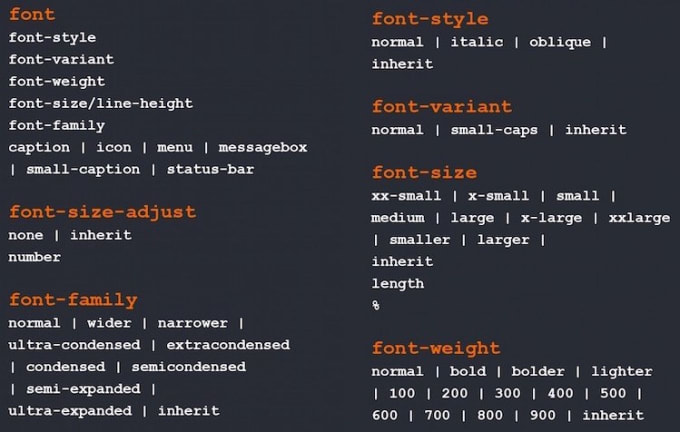
#Oblique vs inherit font professional
So remember: if professional typography is your goal, stay away from any fake, or computer-generated obliques or italics (including those that are commonly created in word-processing programs,) as they will degrade your typography and thus, the overall design.Ĭomputer-generated slanting (shown in red) results in distorted letterforms and inconsistent stroke thicknesses, akin to a fun house mirror effect. True Italics, Mark Simonson describes the work that went into designing the italics for his Proxima Nova family, effectively illustrating the differences between the two. Professional-quality, “true-drawn” obliques and italics are not just computer-generated slanted versions of their roman companions, often referred to as “fake” italics or obliques, but are either hand-drawn or skillfully modified to optically correct the distortion that results from this action. Obliques are a slanted, albeit optically-corrected, version of their corresponding roman, and thus have similar line lengths. For instance, different versions of Helvetica can be found with the same slanted design named both italic and oblique.) (An important point to note is that although this is a broadly accepted naming convention, there are exceptions to this unofficial, yet commonly applied rule. They are most often found in sans serif typeface families, although not all sans serifs have obliques as opposed to italics, as noted above.


Obliques, on the other hand, are simply slanted versions of their roman companion with no major design differences, other than their angle.

Note the character width differences (as noted in the line lengths) between each pair. Many italics are completely different designs from their companion roman, as illustrated by Adobe Garamond (upper) other italics are similar designs that contain a number of varying characters, such as the italics belonging to Enclave (middle) as well as Harmonia Sans (lower). A narrower point would be very position-sensitive, require an extremely light touch from a slow and deliberate hand, and would still tend to be scratchy and not show very much line-width variation.More after the jump! Continue reading below↓įree and Premium members see fewer ads! Sign up and log-in today. We don't recommend starting with anything finer than a Medium nib for customization to either italic or oblique. John loves a left oblique point, but he is also used to the rotation required (the pen must be rotated to the left in order to find the point's "sweet spot"). See our Oblique page for samples and more detailed information. A true Right Oblique point, also called a Reverse Oblique, has a slant exactly the opposite of a Left Oblique and is used by only a few right-handed writers.Īn oblique delivers more subtle line-width variation than stubs and italics because the broadest stroke is the upper-left-to-lower-right diagonal, and if your writing style is typical of most right-handed writers, your characters will have few of these strokes. Unfortunately, some companies, including Parker Pen, call this a Right Oblique. The oblique tip is cut at an angle, usually about 15 degrees, normally from top right to lower left, looking like ones left foot from the top. By contrast, a rounder stub will feel smoother, but not have as distinct a difference between the thin horizontal and broader vertical strokes. See our Stub or Italic pages for samples and more detailed information.

It is also more position sensitive, however the sharper and narrower the point, the less smooth it will feel on paper. A cursive italic point is similar to a stub except sharper, giving more line-width variation between the vertical and horizontal strokes. Stub and Italic CustomizationsĪ stub tip is cut straight across the top and is the easiest to use of the three, since it has somewhat rounded edges and corners. See our Nib Customizations page for samples and more detailed information. While all three of these customizations deliver line-width variation, their differences deserve mention. Different Approaches To Line-Width Variation


 0 kommentar(er)
0 kommentar(er)
